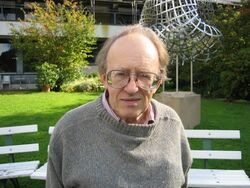Biography:Yuri Burago
Yuri Burago | |
|---|---|
 Yuri D. Burago at Oberwolfach in 2006. Photo courtesy MFO. | |
| Born | 21 June 1936 |
| Nationality | Russia n |
| Alma mater | St. Petersburg State University |
| Awards | Leroy P. Steele Prize (2014)[1] |
| Scientific career | |
| Fields | Mathematics |
| Institutions | St. Petersburg State University |
| Doctoral advisor | Victor Zalgaller Aleksandr Aleksandrov |
| Doctoral students | Sergei Ivanov Grigori Perelman |
Yuri Dmitrievich Burago (Russian: Ю́рий Дми́триевич Бура́го; born 21 June 1936) is a Russian mathematician. He works in differential and convex geometry.
Education and career
Burago studied at Leningrad University, where he obtained his Ph.D. and Habilitation degrees. His advisors were Victor Zalgaller and Aleksandr Aleksandrov.
Yuri is a creator (with his students Perelman and Petrunin, and M. Gromov) of what is known now as Alexandrov Geometry. Also brought geometric inequalities to the state of art.
Burago is the head of the Laboratory of Geometry and Topology that is part of the St. Petersburg Department of Steklov Institute of Mathematics.[2] He took part in a report for the United States Civilian Research and Development Foundation for the Independent States of the former Soviet Union.[3]
Works
- Burago, Dmitri; Yuri Burago; Sergei Ivanov (2001-06-12) [1984]. A Course in Metric Geometry. American Mathematical Society (publisher). pp. 417. ISBN 978-0-8218-2129-9. https://archive.org/details/coursemetricgeom00bura.
- Burago, Yuri (February 1988) [1980]. Geometric Inequalities. Transl. from Russian by A.B. Sossinsky. Springer Verlag. ISBN 3-540-13615-0. https://archive.org/details/geometricinequal0000bura.[4]
His other books and papers include:
- Geometry III: Theory of Surfaces (1992)[4]
- Potential Theory and Function Theory for Irregular Regions (1969)[4]
- Isoperimetric inequalities in the theory of surfaces of bounded external curvature (1970)[4]
Students
He has advised Grigori Perelman, who solved the Poincaré conjecture, one of the seven Millennium Prize Problems. Burago was an advisor to Perelman during the latter's post-graduate research at St. Petersburg Department of Steklov Institute of Mathematics.
Footnotes
- ↑ "The Leroy P Steele Prize of the AMS". n.d.. https://mathshistory.st-andrews.ac.uk/Honours/AMSSteelePrize/.
- ↑ Laboratory of Geometry and Topology
- ↑ U.S. Civilian Research and Development Foundation for the Independent States of the former Soviet Union . 2001 Program Report.
- ↑ 4.0 4.1 4.2 4.3 Bibliography
External links
- Burago's page on the site of Steklov Mathematical Institute
- Yuri Burago at the Mathematics Genealogy Project
- Yuri Dmitrievich Burago[yes|permanent dead link|dead link}}] in the Oberwolfach Photo Collection
 |

